Surfing in Rio: Culture, Techniques, and Community


Intro
Surfing in Rio de Janeiro is more than just a sport; it's a way of life deeply rooted in the culture of this vibrant coastal city. Surfers here find themselves in a unique blend of natural beauty, community spirit, and an exhilarating wave-riding atmosphere. While international surf culture often emphasizes performance and competition, Rio offers an experience that connects local traditions, geographical wonders, and the relentless embrace of the ocean.
From the iconic beaches such as Ipanema and Copacabana to lesser-known spots like Prainha, each location offers distinct characteristics that shape how the waves break. Local surfers share stories of camaraderie and respect for the sea, while also facing the challenges posed by changing environmental conditions and social dynamics. Understanding the will not only prepare enthusiasts for their next adventure but help newcomers appreciate the nuances that define Rio's surfing scene.
Surfing here encapsulates joy, passion, and the quest for balance in the pursuit of riding the perfect wave. The blend of local customs, surf techniques, and ecological awareness paints a rich picture, creating a narrative that appeals to the senses and stirs the soul.
Preamble to Rio Surfing
Surfing in Rio de Janeiro isn't just a sport; it's a way of life. The vibrant waves draw both locals and tourists alike, creating a unique culture that thrives on the sun, saltwater, and the rhythm of the ocean. This introduction sets the stage for understanding why Rio's surfing scene is so captivating, touching on various aspects from its geographical advantages to cultural influences.
The significance of surfing in Rio goes beyond the mere act of catching waves. It's about community, connection, and an enduring spirit of adventure. Think of the surfers who share stories on the warm sands of Ipanema or bond over the struggle of mastering the perfect carve. Local surfers treat the ocean with a reverence that's palpable, where every swell inspires respect and joy simultaneously. This symbiotic relationship between the surfer and nature, in such an electrifying backdrop, is a theme this article explores deeply.
Rio's coastline is dotted with breathtaking beaches that cater to surfers of all levels. Iconic spots like Copacabana and Praia do Leme are more than just picturesque—they offer a variety of conditions, ensuring that there's something for everyone. Whether it's idyllic summer swells or challenging winter waves, the geographic diversity reveals why so many flock to these shores.
Benefits of Understanding Rio Surfing
Comprehending the dynamics of Rio surfing enables enthusiasts to appreciate the complexities of the sport:
- Skill Development: Knowing the types of waves helps surfers hone their skills effectively.
- Cultural Awareness: Engaging with local surfers provides unparalleled insights into the cultural tapestry that shapes the surf scene.
- Environmental Consideration: Understanding the delicate ecosystems along the coast can lead to more responsible surfing practices.
Each wave carries its own story, much like the surfers who ride them. By diving into this article, readers can expect a comprehensive exploration of not only the act of surfing but also the lifestyle and passion intertwined with it.
Geared for athletes, outdoor enthusiasts, and those just starting their adventures, the section ahead will detail the geographical landscape that frames Rio surfing. Partnered with rich narratives, interviews, and practical insights, this article aims to be an essential guide for anyone looking to dive deeper into the waves of Rio.
The Geographical Landscape
The geographical features of Rio de Janeiro provide a rich backdrop for surfing. The way the land meets the ocean plays a key role in shaping the waves, attracting surfers from around the world. From the coastal contours to the urban sprawl, each element contributes to an environment that supports both casual surfers and seasoned professionals. Understanding this landscape allows surfers to pick the right spots for their skill levels and preferences, enhancing their experience.
Coastal Topography
Rio's coastline is a blend of rocky cliffs, sandy beaches, and lush green hills. This variety creates diverse wave conditions that can cater to different styles of surfing. For example, the steep cliffs overlooking some beaches can generate powerful waves as the swells hit the shoreline at full force. These geological features can produce thrilling surf but also present challenges. Water depth and bottom structure vary significantly, which is crucial for surfers to consider for safety and skill development.
Key Surfing Beaches in Rio
Copacabana
Copacabana is not just a beach; it's a symbol of Rio itself. The unique crescent shape of the coastline makes it a prime location for surfers of all levels. One distinct aspect is the iconic black and white wave pattern in the promenade. This beach often attracts large crowds, making it popular. However, the hustle and bustle can be both a draw and a distraction. Surfers here enjoy socializing, but must also navigate through throngs of sunbathers and tourists. The waves vary throughout the year, providing something for everyone.
Ipanema
Ipanema stands out for its stunning scenery and vibrant atmosphere. The waves here tend to be more suited for intermediate and advanced surfers, as they can become quite powerful, particularly during summer. The consistent swell from the Atlantic Ocean offers reliable conditions. However, beginners need to be cautious and perhaps opt for lessons at local schools. The beach's surrounding bars and cafes contribute to its lively vibe but can also present a challenge when managing gear and equipment.
Praia do Leme
A lesser-known gem, Praia do Leme is located at the northern tip of Copacabana. Its relatively quieter and less crowded beach makes it a unique spot for seasoned surfers seeking a calmer environment. The waves can be more forgiving, which is great for honing techniques. The atmosphere is laid-back, and those who know it treasure the sense of community amongst surfers. However, accessing this beach might require a bit more effort, but the tranquility it offers is often worth the trip.
Praia Brava
True to its name, Praia Brava is known for its fierce and impressive waves, catering primarily to experienced surfers. The beach's rugged backdrop gives it an untamed charm, and its powerful swells makes it a thrilling choice for those wanting to test their skills. While the scenery is breathtaking, the harsher conditions can also be daunting, making it less suitable for novices. This beach offers a picturesque escape, but often requires a healthy respect for the ocean's might.
Riptides and Currents
Riptides and currents can be a surfer’s best friend or worst enemy, especially in a dynamic place like Rio. Understanding these natural phenomena is crucial for safety. Some beaches, like Ipanema and Copacabana, are known for their surf breaks but can also have tricky riptides, particularly during high tide. Surfers must be educated about the signals indicating riptides and should never underestimate the ocean's power. Knowledge gained from local surfers or instructors can greatly enhance one's surfing experience while minimizing risks.
Remember: Always check local conditions and heed advice from community sources to stay safe while enjoying the surf.
Surfing Conditions
Understanding the surfing conditions in Rio de Janeiro is crucial for any enthusiast hoping to ride the waves with competence and confidence. The conditions can vary drastically from one season to another, influenced by a range of factors including wave patterns, seasonal swells, and weather variations. It’s about more than just catching a wave; it’s about adapting to the unique character of Rio's coast and maximizing each surfing opportunity.
Wave Patterns and Swells
In Rio, wave dynamics are largely influenced by coastal geography and atmospheric conditions. When the winds from the ocean hit the coastline, they create specific wave patterns. Surfers often analyze these patterns to determine the best surf spots and times of the day to hit the water.
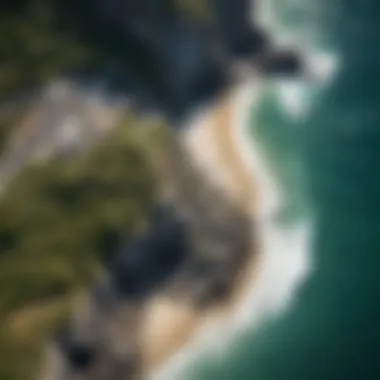
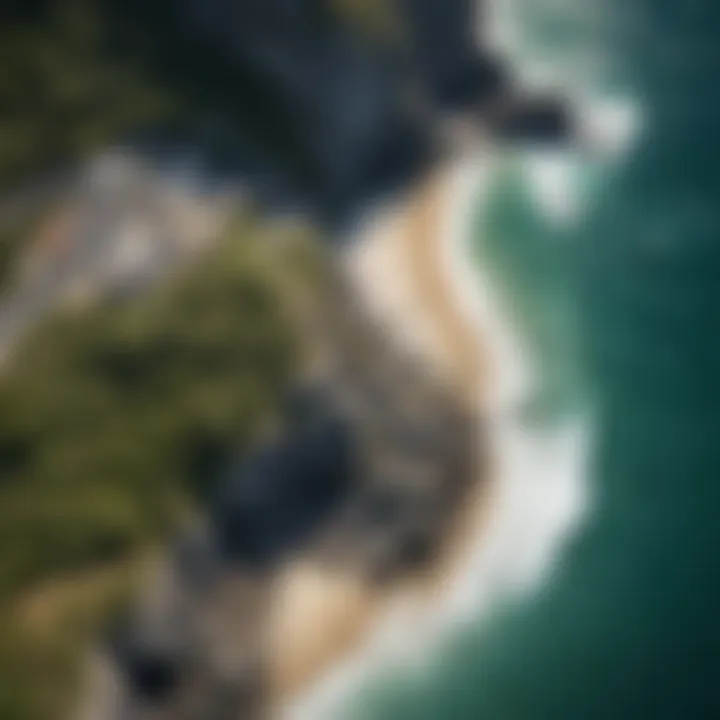
These patterns can be different depending on the season and local currents.
- Diverse Wave Profiles: Depending on the beach, surfers might encounter mellow beach breaks or powerful reef breaks.
- Timing: Early mornings often present the cleanest waves, thanks to calmer winds.
Being in tune with these wave characteristics not only enhances the surfing experience but also improves safety and skill development.
Seasonal Variability
Summer Swells
Summer in Rio is characterized by swells that can bring lighter, yet often more playful waves. During this season, the water temperature rises, enticing more surfers to the beaches. The main aspect of summer swells is their consistency; they provide a wealth of opportunities for novice and experienced surfers alike.
- Key Characteristic: The waves tend to be softer and more forgiving.
- Popular Choice: Ideal for long rides that allow learners to practice.
One unique feature of summer swells is the frequency of swells every few days, which keeps the surfing scene lively. The downside, however, might be the crowding of beaches, as many surfers flock to them.
Winter Waves
Winter brings a different vibe to Rio's surfing conditions. The waves become powerful and challenging, making it a prime time for advanced surfers. Winter waves often carry more heft, which means they hit harder.
- Key Characteristic: Generally stronger waves with more volume.
- Benefit: They can create good barrels for skilled surfers to enjoy.
The unique feature of winter waves is their capability to produce some of the best surfing conditions during storms offshore. However, the trade-off is that they can be much less forgiving, which can lead to more dangerous situations for those not prepared.
Weather Influences
Weather plays an essential role in shaping surfing conditions in Rio. With its tropical climate, sudden changes in weather can lead to rapidly changing surf conditions. Wind direction, storm patterns, and rainfall all affect the quality of waves.
- Wind Patterns: Offshore winds can clean up choppy waters, while onshore winds can create rough conditions.
- Tides: Understanding the tidal movements is also important, as they can significantly affect wave height.
Many local surfers keep a close eye on weather forecasts to predict the best times for surfing, often relying on apps and websites to guide their decisions.
"Surfing is as much about understanding your environment as it is about skill on the board."
Cultural Aspects of Surfing in Rio
Surfing in Rio de Janeiro is not just a sport; it’s a way of life deeply woven into the fabric of local culture. The shoreline is as much about the waves as it is about the people who ride them. The cultural aspects surrounding this thrilling activity highlight elements of community, identity, and creativity. These factors contribute significantly to the overall surfing experience, making it rich and vibrant, especially for those looking to understand the soul of Rio's surf scene.
The Surfing Community
Local Surfers
Local surfers in Rio are not your average wave riders; they embody the heart and soul of the city’s surfing culture. They are often seen as the torchbearers of local knowledge, passing down wisdom about the best spots and optimal surf conditions.
These surfers, hailing from various backgrounds and skill levels, create a tapestry of diversity. Their camaraderie fosters an environment where newcomers are welcomed. This is critical for the overall growth of the surfing scene. The key characteristic here is the strong sense of community. For someone new to surfing in Rio, connecting with local surfers can make all the difference, offering insights that no guidebook can provide.
A unique aspect of local surfers is their intimate understanding of the conditions in Rio, making them invaluable for safety and guidance. They know when and where the waves are at their best, and can give tips that enhance a newcomer’s surfing journey. However, one downside might be that sometimes, the most popular spots can feel exclusive, as established surfers often prefer to maintain their favorite waves.
Surfing Schools
Surfing schools are an essential part of the Rio surfing culture, serving as the gateway for many into this exhilarating sport. These schools are often run by experienced surfers who take up the mantle of education, teaching newcomers the ropes—or, ideally, how to ride them.
The key characteristic of these schools is their focus on safety and instruction, ensuring that students not only learn to surf but do so in a responsible manner. They often use a hands-on approach, pairing students with instructors who cater to their individual needs and learning paces. This personalized experience makes surfing schools a popular choice among novices, as they offer a welcoming environment where fears can be alleviated.
A unique feature of surfing schools in Rio is their integration of local culture into the curriculum. Many include lessons on ocean conservation, understanding local wildlife, and respecting surf etiquette. This well-rounded approach helps students appreciate the broader context of surfing. However, the downside could be the cost, as not everyone can afford lessons when equipment rental adds up as well.
Surfing Events and Competitions
Surfing events and competitions in Rio have become focal points of local culture, attracting international attention and participation. Notable events include the Rio Surf Pro and other local surf contests that showcase both amateur and professional talent.
These events do more than entertain; they serve as platforms for local surfers to gain recognition while also promoting the city as a prime surfing destination. Spectators experience a vibrant atmosphere with music, food, and art, creating a festival-like ambiance that resonates with the Rio lifestyle.
Art and Surf Culture
The intersection of art and surf culture in Rio is fascinating. From graffiti murals on the streets celebrating local surf legends to art exhibitions showcasing ocean-inspired works, creativity thrives within the surfing community. Many surfers are also artists, contributing to a unique cultural expression.
Surfboards are often customized as canvases, turning them into functional art, further blending the creative landscape with the surfing scene. This artistic vibe not only enriches the culture but also brings more attention to the environmental issues facing beaches and oceans. The collaboration between artists and surfers ignites awareness, encouraging conservation efforts, which is essential in protecting the very waves they ride.
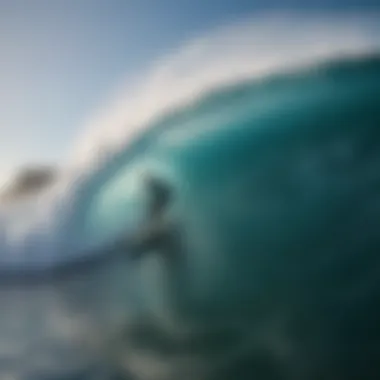
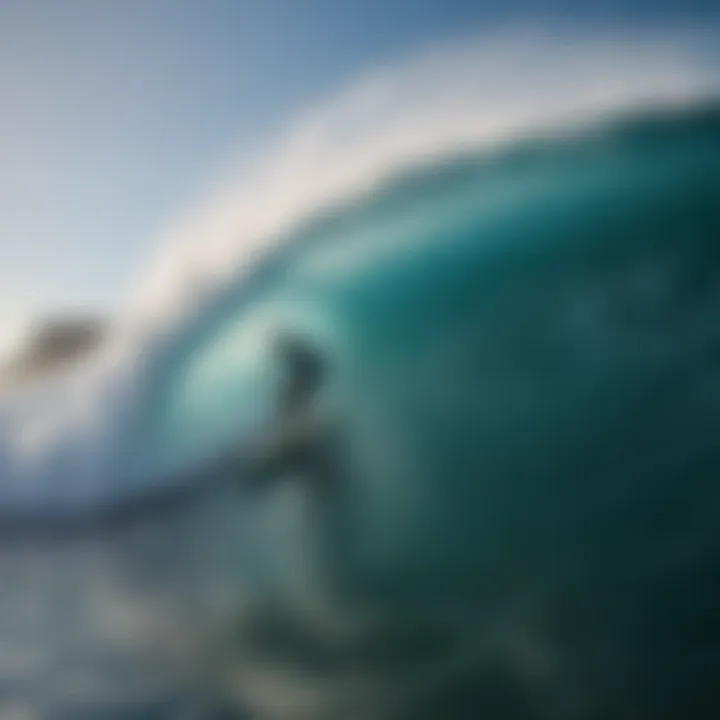
"Surfing in Rio is more than just about catching waves; it's about a lifestyle, a passion, and a vibrant community that embraces diversity and creativity."
Techniques and Skills Development
The journey of mastering surfing in Rio is not just about riding the waves; it's about continuously enhancing one's techniques and skills. For surfers of all skill levels, understanding the fundamental practices and advanced maneuvers can significantly elevate their experience. It helps in navigating the dynamic waters of Rio, ensuring both thrilling rides and safety in challenging conditions. Techniques are the backbone of the sport, allowing surfers to express themselves creatively while managing the demanding ocean environment.
Fundamentals of Surfing
At the heart of surfing, the fundamentals lay the groundwork for all other skills. Basics like paddling, duck diving, and popping up are essential. Paddling is an art in itself; the right technique helps conserve energy and lets surfers catch waves more efficiently. Getting the timing right for popping up stands crucial for maintaining balance and positioning on the board.
Moreover, understanding how to read the waves is invaluable. Recognizing the direction of swells and the shape of breaking waves can help surfers choose the right moment to take off. These foundational skills build confidence, allowing surfers to explore more advanced techniques as they progress.
Advanced Surfing Techniques
Carving
Carving is one of the more sought-after techniques among seasoned surfers. It isn’t merely about turning; it's about fluidly shifting weight and directing the board's trajectory through the wave. The key characteristic of carving is that it allows for powerful pressure on the rail, enabling control over the ride. This method gains popularity in Rio, where the waves offer the perfect canvas for demonstrating one’s skills.
The unique edge of carving lies in its ability to generate speed while maintaining grip on the wave face. A surfer who masters carving can perform stylish transitions, making it visually impressive. However, it requires significant strength and balance. Overdoing the edge could cause a wipeout, so finesse is essential.
Cutbacks
Cutbacks serve as both a practical maneuver and a stylistic expression in surfing. They involve turning back toward the white water of the wave face after riding down the line. The highlight of cutbacks is this ability to regain the power of the wave while modifying direction. It's a beneficial choice in competition as it maintains momentum and shows control.
The unique feature of cutbacks is the opportunity it gives surfers to blend rhythm with sharp turns. This style creates a seamless connection with the wave, giving judges a view of versatility. Nevertheless, it takes time to perfect; surfers learning cutbacks need to be aware of timing to avoid getting caught by waves.
Air Moves
Air moves grant surfers a chance to express creativity airborne. It involves launching the board off the lip of a wave, performing tricks before landing back on the wave face. The key trait of air moves is that they heighten the thrill and excitement of surfing in competitive arenas. This technique often garners the crowd's applause and admiration.
A unique aspect of air moves lies in their requirement for a fine balance between speed, timing, and technique. Successfully completing an air trick can elevate a surfer’s profile significantly. However, the risk factor is undeniable as miscalculating can result in falls that are both daunting and painful. Surfers must weigh the excitement of air moves against the potential for accidents while gauging their own skill levels.
Mentorship and Coaching
Having access to mentorship and coaching can dramatically affect a surfer's development. An experienced coach can provide tailored advice that addresses specific weaknesses, while also cultivating strengths. Mentorship often bridges theory into practice, helping beginners grasp the ocean’s nuances faster. It also encourages a positive environment, fostering camaraderie among surfers and enhancing their general experience.
While many surfers learn gear-makes on their own at local beaches, pairing up with skilled instructors in Rio can lead to rapid improvement. By sharing techniques that reflect their own experiences, seasoned surfers can help newcomers understand the intricate dance between rider and ocean. This collaborative approach makes the surfing journey richer and more rewarding.
Environmental Considerations
Surfing in Rio de Janeiro is not just about riding the waves; it intertwines with the environment in significant ways. Environmental considerations play a vital role in shaping the sustainability of this beloved sport. Many surfers might not realize that their actions can impact local ecosystems, but understanding these aspects is essential for preserving surfing conditions and ensuring that the sport thrives for future generations.
Responsibility of Surfers
Surfers should embrace a sense of stewardship towards the coastal regions they frequent. This means adopting practices that minimize their ecological footprint. Here are some fundamental responsibilities:
- Educate themselves about local wildlife and ecosystems. Being familiar with protected species or habitats can make a big difference in how surfers interact with their surroundings.
- Choose eco-friendly products. For instance, surfboards made from sustainable materials or biodegradable wax contribute to reducing damage to the oceans.
- Participate in beach cleanups. Engaging in community efforts to remove trash from beaches fosters a healthy environment and enhances the surfing experience.
By being mindful of their impact, surfers can cultivate a culture of respect for nature.
Impact of Pollution
Pollution poses a significant threat to surfing conditions in Rio. From plastic waste to chemical runoff, the consequences can be dire:
- Water quality issues can deter surfers from hitting the waves. High levels of bacteria from sewage discharge can lead to illnesses, making pristine surf spots hazardous.
- Marine life is affected as chemicals seep into the water. Heavy metals and toxins can disrupt entire ecosystems, harming species that make the ocean their home.
Raising awareness about pollution is crucial. Surfers often act as environmental defenders—by speaking up and showing concern for the health of their surf spots, they can foster change.
Conservation Efforts
In recent years, several initiatives have surfaced to combat the adverse effects of pollution on surf breaks. Here’s a glance at some notable conservation efforts:
- Beach Cleanups and Monitoring: Many organizations now host regular events aimed at cleaning and maintaining popular surfing areas. This not only improves conditions for surfing but also raises public awareness.
- Legislative Advocacy: Collaborating with local authorities to create and implement policies could help regulate waste disposal and protect marine life. For example, advocating for stricter regulations on sewage treatment can lead to cleaner waters.
- Habitats Restoration: Projects aimed at restoring coastal habitats can have lasting benefits. Restoration of mangroves and coral reefs can bolster the natural defenses of beaches against pollution and erosion.
"Conserving our ocean isn’t just about saving waves, it’s about saving a way of life."
The beauty of surfing in Rio isn’t just found in the waves; it’s nestled in the rich ecosystems that surround them. By prioritizing environmental considerations, surfers contribute to a legacy that embraces not just their passion, but the world they surf in.
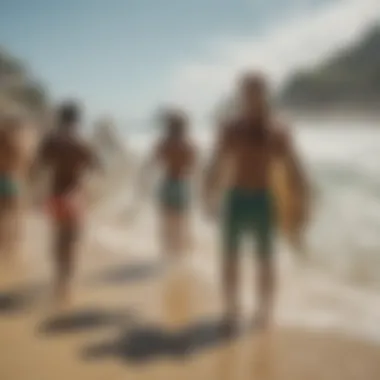
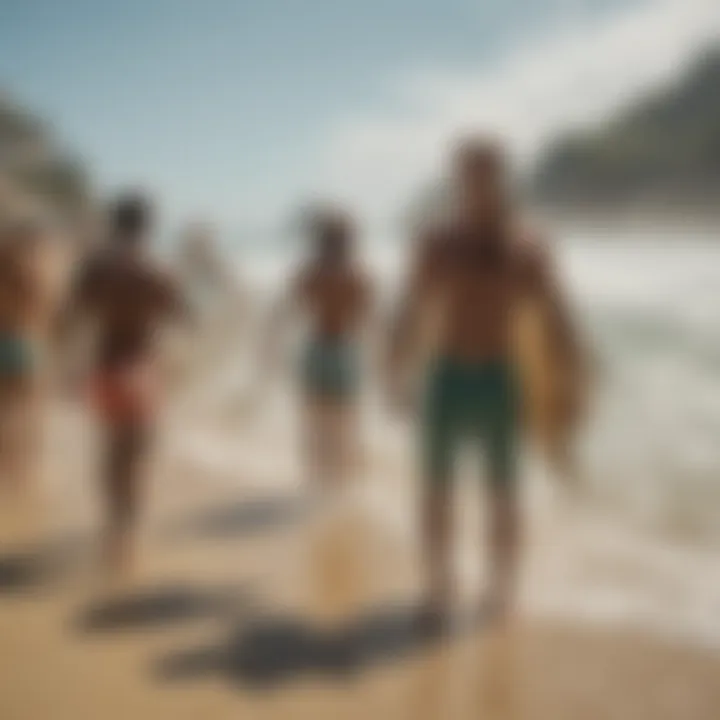
Challenges Faced by Surfers
Surfing in Rio de Janeiro is not all sunshine and smooth waves; it comes with its fair share of challenges that can test even the most seasoned riders. Understanding these obstacles is crucial for anyone looking to embrace the surf lifestyle here. From competition among local surfers to the physical dangers of the ocean, these challenges shape the surfing experience in significant ways.
Competitive Landscape
The surfing scene in Rio is vibrant but intensely competitive. With the city's picturesque beaches attracting surfers from all corners, both local and international, the waters can sometimes feel crowded. This competition can foster talent, encouraging surfers to sharpen their skills in pursuit of respect and recognition.
However, it can also lead to tension, especially when waves are scarce on a busy day. Surfers must navigate their way through the unspoken rules of wave priority, which can sometimes prompt disagreements among wave riders.
To thrive in such an environment, one must be attuned to the dynamics of the local surf community. Building relationships with other surfers and respecting established norms is critical. Those who contribute positively to the local scene often find support and camaraderie, easing some of the competitive pressure.
"In the lineup, respect is currency. Treat others well, and they’ll treat you back."
Safety and Hazards
When venturing into Rio's waters, safety should be a priority. The ocean can be unpredictable; riptides and rocky outcrops present real hazards. For surfers unfamiliar with local conditions, navigating these dangers can be daunting. Knowing how to read the water is essential.
Surfers should keep an eye on the weather, as sudden storms can create dangerous conditions. It’s wise to familiarize oneself with the specific beaches, as they vary greatly in terms of wave behavior and potential dangers. Local surf schools often offer valuable insights into safety practices and how to handle the unique challenges each beach presents.
Additionally, beachgoers should be aware of the risk of shark sightings, which, although rare, can occasionally occur. This adds another layer of caution for surfers dipping into the ocean.
Economic Factors
The financial landscape in Rio plays an intriguing role in surfing. For many local surfers, the sport is a way of life, yet it comes with economic challenges. The costs associated with gear, lessons, and even travel to better surf spots can quickly add up. Daily life for many can be a balancing act between pursuing their passion for surfing and managing financial constraints.
Some local surfers have turned to surf coaching or guiding as a means to support themselves while staying close to the waves. This entrepreneurial spirit not only helps them financially but also enriches the community, enabling knowledge transfer to newcomers eager to learn the ropes.
Moreover, rising pollution and environmental challenges in coastal areas affect not only the health of surf spots but also the local economy reliant on tourism. Eco-friendly practices are increasingly promoted among surfers, marrying the love of the ocean with responsible stewardship, potentially safeguarding this cherished resource for future generations.
Future of Surfing in Rio
The future of surfing in Rio hinges on a mix of factors ranging from evolving wave patterns to cultural shifts. As we look ahead, the significance of understanding these dynamics cannot be overstated; it shapes not only the sport but also the local community and environment. The thrilling waves that define Rio are influenced by climate change, urbanization, and increasing global interest in this iconic sport.
Identifying specific elements at play is crucial, especially for athletes seeking to enhance their skills or instructors aiming to adapt their teaching methods.
Emerging Trends
Surfing in Rio is witnessing some exciting trends that hint at how the sport may evolve. For one, there is a noticeable increase in the number of young surfers. Kids are gravitating towards surfing as a lifestyle, spurred by access to social media showcasing spectacular surf clips and the culture surrounding it. This transition leads to a more vibrant scene, encouraging mentorship and learning opportunities among various skill levels.
Among these trends, eco-conscious practices are taking root. Surfers are becoming more aware of sustainability, pushing for clean beaches and responsible surfing, understanding full well that the very waves they ride are sensitive to environmental disruption. They emphasize using eco-friendly gear, like boards made from recyclable materials, and organizing cleanup drives at local beaches. All these trends contribute to a healthier surfing culture, which ultimately enhances the overall experience.
Technological Advances
In the realm of technology, innovation has begun to change the surfing world. The advent of smart wetsuits, for example, allows surfers to track their performance metrics. These suits provide information on wave conditions, body temperature, and even surf technique, giving surfers insights that were previously hard to come by.
Drones have also found their way into the surf landscape. These devices help with ocean monitoring, providing data on wave formations, currents, and the behavior of surf spots. This information helps surfers and instructors alike make informed decisions about when and where to catch waves effectively.
Moreover, some new surf spots are emerging thanks to advanced forecasting apps that now allow surfers to check conditions in real time, down to minute changes in tides. The innovation doesn’t stop there; augmented reality is on the horizon, with potential applications in training and technique enhancement.
Community Initiatives
Community initiatives are becoming a cornerstone of surfing in Rio. Local surfers and environmental groups are teaming up to create programs that not only promote surfing but also advocate for the preservation of the coastal ecosystem. These programs include educational workshops covering topics such as marine biology, waste management, and the importance of sustainable surfing practices.
Furthermore, the focus on inclusivity is growing. More surf schools are empowering marginalized groups with access to surfing lessons and resources.
- Weekly surf camps for underprivileged youth are gaining popularity, combining skill development with community building.
- Adaptive surfing organizations are also making waves, ensuring that individuals with disabilities find a place in the lineup.
Bringing everyone together—regardless of age or ability—helps foster an environment where surfing is cherished and respected. Understanding these initiatives not only informs future surfers about their community but also enriches the culture that envelops this exhilarating sport.
"The ocean is not just a playground. It is an ecosystem that thrives when nurtured; it’s our playground, our responsibility."
The future of surfing in Rio is not just about catching waves but about building a community that values the ocean's fragility. This cooperative spirit will certainly contribute to a more sustainable and vibrant surfing culture that resonates well beyond the shores of Rio.
Finale
As we wrap up this exploration of surfing in Rio de Janeiro, it’s worth reflecting on what makes this vibrant coastal city, a haven for surfers, stand out from the rest. Rio is more than just beautiful beaches and consistent waves; it embodies a culture deeply interwoven with the sport. The surfing experience in Rio is a tapestry of local traditions, competitive spirit, and environmental consciousness, making it a unique locale for both seasoned athletes and newcomers to the scene.
The cultural significance of surfing here cannot be overstated. Local surfers often use their skills not just for sport, but also as a way to bond with the community, tell stories, and share experiences. The surfing lifestyle in Rio transcends the waves; it’s about community, sharing knowledge, and nurturing the next generation of surfers. Events and competitions not only highlight talent but act as a celebration of the surfing culture that thrives in the city.
Environmental awareness has also found its place in the surfing community. Surfers in Rio are increasingly conscious of their impact on marine life and coastal ecosystems. The conversation around pollution and conservation is becoming more prevalent, encouraging surfers to adopt sustainable practices. This shift towards environmental responsibility is beneficial for the health of the sport, the ocean, and the community at large.
Challenges do exist, be it the competitive landscape or safety concerns in more turbulent waters. Yet, they add a layer of complexity that ultimately enriches the surfing experience. The resilience displayed by the surfing community in addressing these issues speaks volumes about their passion for the sport and their commitment to improving their environment.















